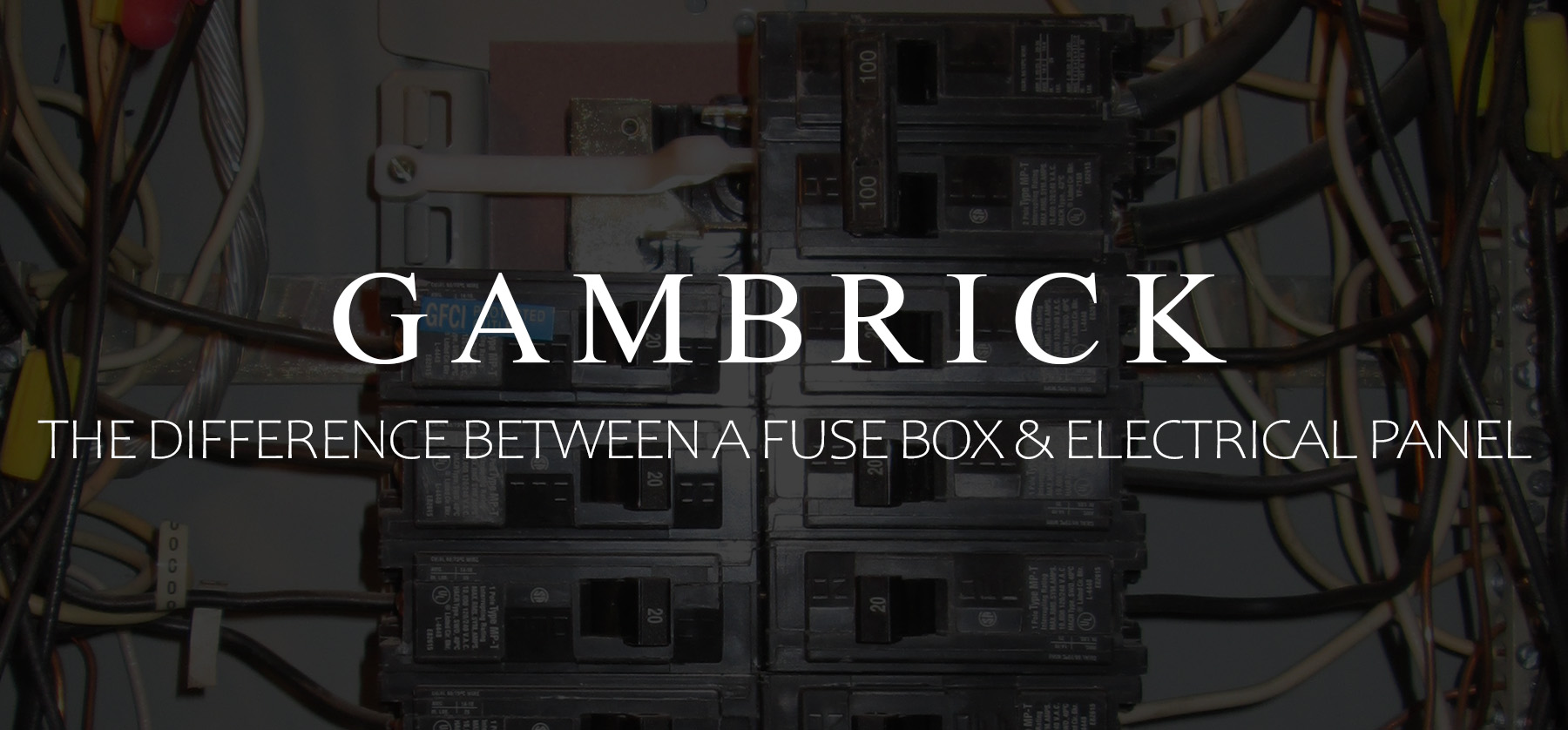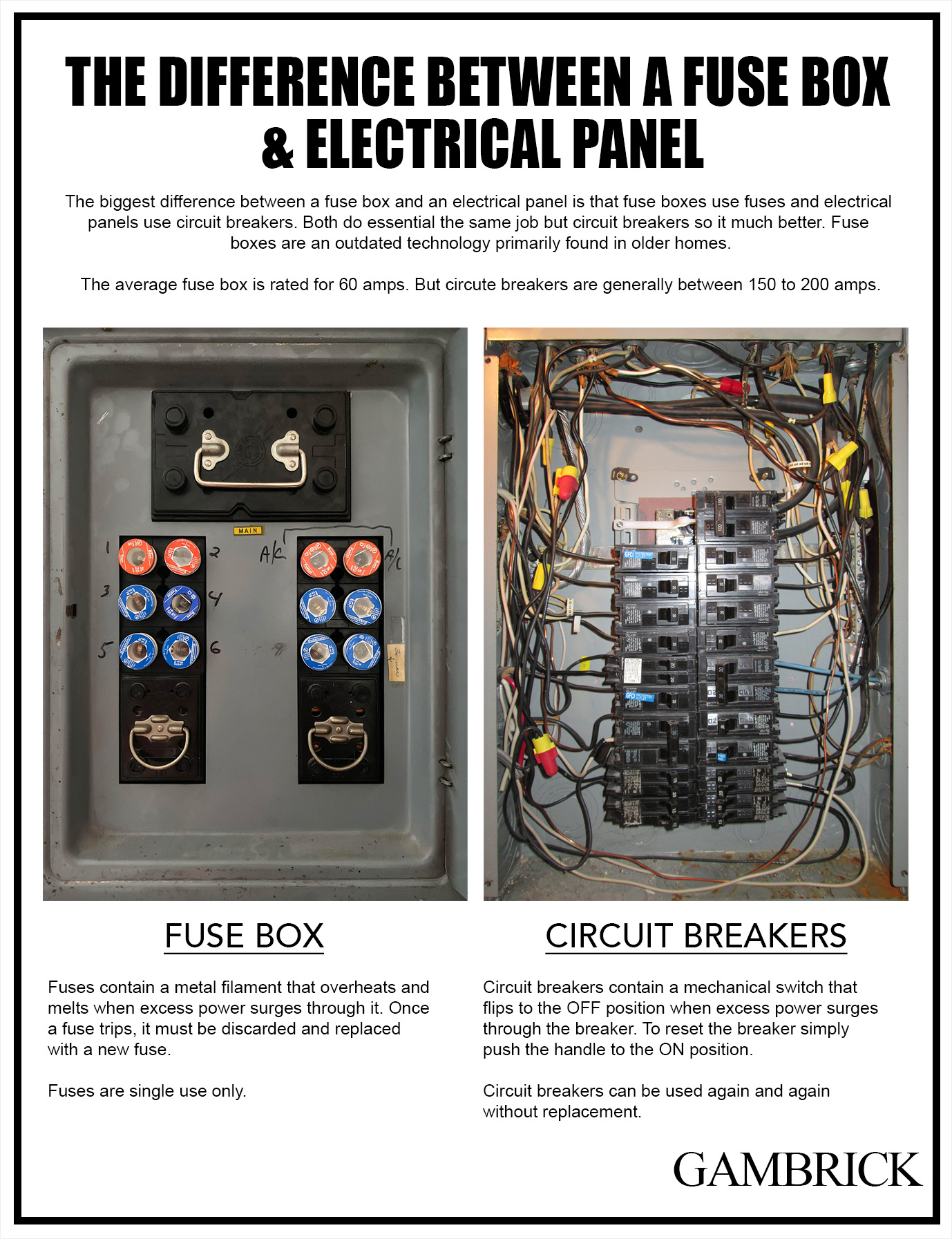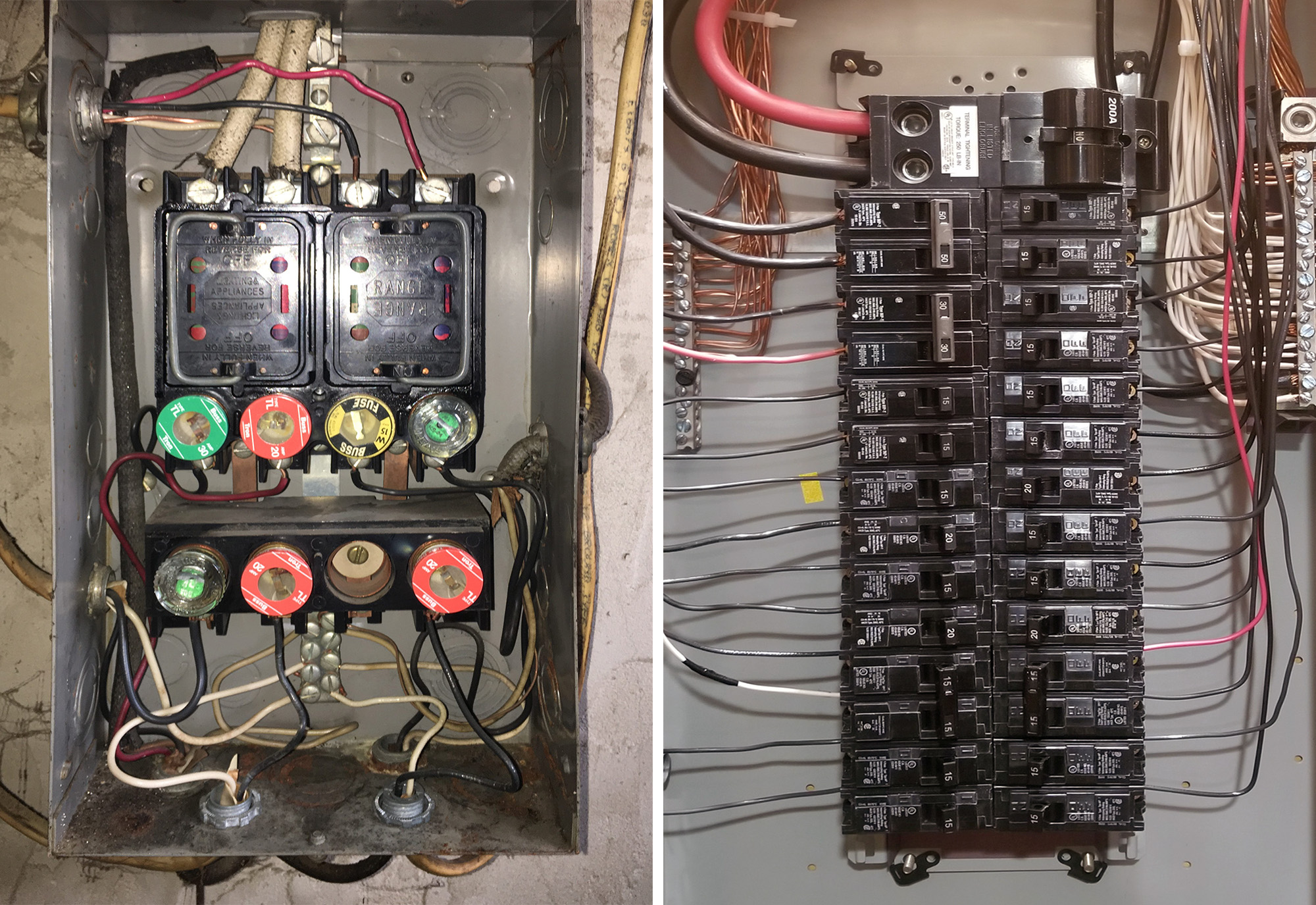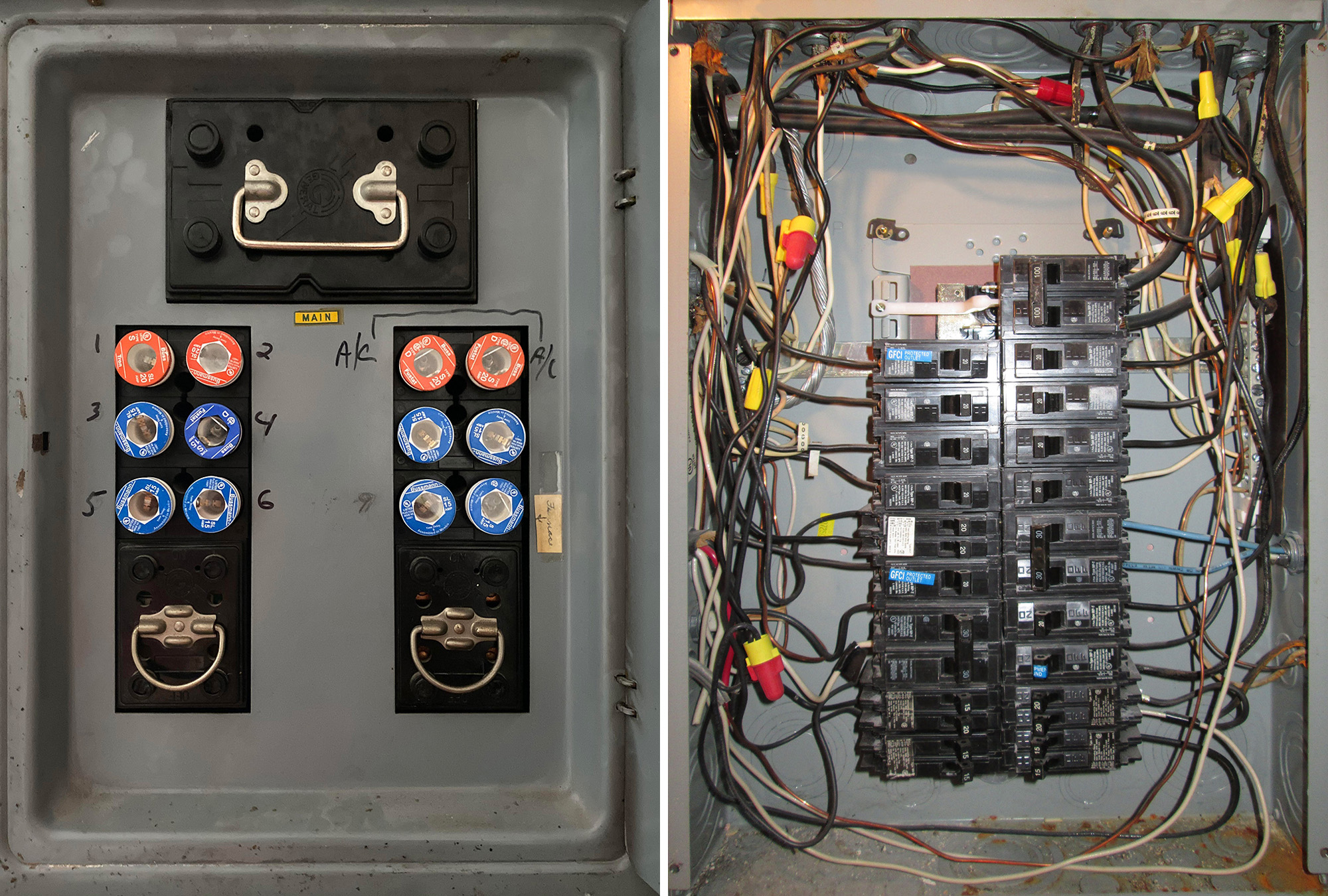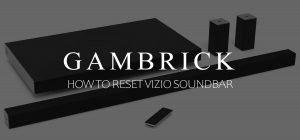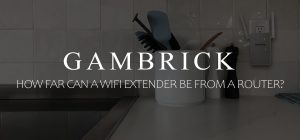The Difference Between A Fuse Box & Electrical Panel
The biggest difference between a fuse box and an electrical panel is that fuse boxes use fuses and electrical panels use circuit breakers. They look similar on the outside, but it’s easy to tell the two apart when you open the panel. Electrical panels have black, rectangular shaped circuit breakers inside. A fuse box has small circular fuses instead of breakers. Both fuses and breakers should be labeled to show which circuit they control. Fuse boxes and electrical panels serve the same basic purpose. They interrupt and allow electricity to flow from the main power line through the circuits to all your outlets, lights, appliances, etc. But they do it in a different way.
Fuses and circuit breakers are both part of an electrical panel. The electrical panel is a metal service box that accepts the main power from your utility company. It distributes electrical current through breakers or fuses to circuits within your home. An electrical panel is located inside the house and is the homeowner’s responsibility to maintain.
The distribution of power to circuits throughout the home originates at the panel. Each individual circuit is protected from over-current by either fuses or circuit breakers.
The main difference between fuse boxes and electrical panels are the fuses and circuit breakers.
- Fuses can only be tripped one time. They have a filament inside that breaks when it trips. To restore power you have to replace the entire fuse.
- Circuit breakers can be tripped hundreds of times without having to replace them. They can be turned on and off as easy as flipping a light switch.
Another difference is power. Circuit breakers can handle more power than fuses which is essential in modern homes which use more electricity than they used to.
What Is A Fuse Box & How Does It Work?
A fuse is an over-current safety device that’s part of the electrical panel. If too much power surges through a circuit the fuse will trip and break the flow. They’re basically just a piece of metal that melts when it overheats. And this is the fuses biggest drawback. Once a fuse is blown, it cannot be reused. It must be discarded and replaced with a new fuse of the same type and amperage rating.
Fuse boxes are primarily found in older homes. Electrical panels with circuit breakers replaced fuse boxes because breakers can be re-used and fuses can’t. Breakers can be tripped hundreds of times without breaking and turned off and on as easy as flipping a light switch.
Fuses come in different types, but the most common design contains a thin wire filament enclosed in glass or ceramic which is housed within a metal casing.
- Fuses are plugged into a fuse box which houses wiring for all of the home’s electrical circuits.
- Each circuit has it’s own fuse.
- When the fuse is inserted into the box, the circuit is complete and electricity can flow.
- When the fuse is removed or tripped, the circuit is broken and electricity can not flow.
In the event of an electrical overload, the excessive heat will melt the fuse’s filament. This immediately stops the flow of electricity before the excess current can damage your home’s wiring or create a fire hazard. But it also destroys the fuse.
Fuses come in different amperage ratings that handle various amounts of electrical current.
For safety reasons, never use a fuse rated higher than the manufacturer intends for the circuit. This would allow excessive current to pass through, causing overheating in the wires and a possible electrical fire.
What Is A Circuit Breaker?
A circuit breaker is an electrical safety device designed to protect an electrical circuit from an over-current or short circuit. They’re installed inside of an electrical panel. Breakers work just like a fuse except they can be reset again and again without breaking. Each circuit breaker contains an internal switch that can be flipped on or off by a handle. When the breaker is on, electricity can flow through the breaker. When it’s off, the circuit is broken and electricity can not flow.
Electricity from your utility flows into the home through an electrical panel. Then power is sent to various circuits throughout the home. Each circuit has its own a circuit breaker.
A residential circuit breaker uses either an electromagnet or a bimetallic strip connected to a simple switch.
- Electromagnet Circuit Breaker: Excessive electrical current create a magnetic force strong enough to throw a metal lever in the switch to OFF, breaking the current.
- Bimetallic Strip Breakers: Consist of two strips of two different types of metal. Excessive current causes the thinner of the two strips to bend which throws the switch to OFF and breaks the circuit.
Unlike fuses, circuit breakers can be reused again and again because they don’t contain a filament.
To resume the flow of electricity after the breaker is turned OFF, simply press the handle back to the ON position. This simple switch action makes it easy to shut off electricity to individual circuits whenever necessary.
Like fuses, circuit breakers come rated for different amperage levels which is usually printed on the handle.
For safety reasons, never use a breaker rated higher than the wiring for the circuit can handle. This would allow excessive current to pass through, causing overheating in the wires and a possible electrical fire.
Fuse Box vs Circuit Breaker
Fuse boxes are primarily found in older homes. So replacement fuses can be hard to find and expensive. Unless a homeowners wants to preserve the design of a historic home, it’s almost always better to upgrade an old fashioned fuse box to a modern electrical panel.
Circuit breakers are basically a modern type of fuse that can be used again and again without breaking. They’re cheaper, easier to find, handle more power and protect against electrical shock.
| FUSE | CIRCUIT BREAKER | |
| Function | Detection & interruption | Interruption Only |
| Operation |
Based on a conducting material heat tolerance which melts a filament during overload | Based on an electromechanical principle which flips a switch during overload |
| Operation Mode |
|
|
| Response Time | ~ 0.002 seconds | 0.1-0.2 seconds |
| Breaking Capacity | Small | Large |
| Protection | Protects against overload | Protects against overload & short-circuits |
| Application | Low current electronic equipment | Large current power equipment |
Circuit breakers perform the same basic function as a fuse but do it in a much better way. Because they don’t contain a filament, you can trip them again and again without replacing them. Contrast that with fuses which need replacing every time it trips.
If you don’t have a replacement fuse on hand, there’s no way to restore power to the circuit until you get a new one. And since they’re an older technology, replacements can be hard to find and expensive.
Circuit breaks can hands more power. The average fuse box was designed for around 60 amps. Compare that to modern electrical panels that are typically rated for a 200 amp service. Modern homes simply require more power which requires breakers.
Should I Replace My Fuse Box With An Electrical Panel?
In almost all cases the answer is yes. You should replace your old fuse box with a modern electrical panel and circuit breakers. They perform the same basic function as fuses but do it in a much better way. And they provide several advantages like more power, longevity, better protection and they’re cheaper and easier to find. Modern homes use more electricity than old homes so they need an upgraded electrical panel and breakers.
Older homes had much less demand for electricity compared with modern homes. Old fashioned fuse boxes were generally designed to handle a 60 amp service. But most electrical panels are designed for a 200 amp service. Which is needed considering how many devices run on electricity these days.
In addition to being outdated and difficult to maintain, fuse boxes don’t supply enough electricity for most modern homes. They generally lack dedicated circuits needed for large appliances like air conditioners, dishwashers, clothes dryers, microwaves and electric ranges.
It’s common for homeowners with fuse boxes to frequently overload circuits and blow fuses when trying to power modern appliances and devises.
Here are some warning signs that your fuse box can’t handle the home’s power needs:
- Fuses need frequent replacement
- You’re unable to run large appliances together without tripping a fuse
- The fuse box makes hissing or popping sounds
- The wall around electrical outlets or switches feels warm
It’s important to have a licensed electrician upgrade your outdated fuse box to an electrical panel. If you notice any of the above issues I would call one right away.
Do Insurance Companies Insure Homes With a Fuse Box?
Many insurance companies will not insure a home with a fuse box. Because fuse boxes are an outdated technology some insurance companies view them as a potential hazard. They simply can’t supply the amount of power required by the average modern home.And it can be hard to find replacement fuses when one trips. This means you’ll have no way to restore power until you find a replacement fuse.
Most fuse boxes were rated for around 60 total amps. Compare that to the average modern home built today which uses a 150 to 200 amp service. New appliances like A.C. units, refrigerators, microwaves, electric water heaters, electric ranges, etc. require dedicated circuits and more power. This isn’t something a fuse box can do.
Some insurance companies will still insure home’s using a fuse box. But it may cost more money for the premium because there’s a higher risk of overloading a circuit which may cause a fire.
What’s The Difference Between A Circuit Breaker & A Fuse Box?
The main difference between a fuse and a circuit breaker is that fuses can not be reused after they trip but circuit breakers can. Both fuses and circuit breakers protect a home against overload. When excess amount of power runs through a circuit, both a fuse and circuit breaker will trip which stops the flow of electricity. When this happens, you can simply reset the breaker by pushing the handle to the ON position. But fuses are permanently disabled when they trip. So in order to restore power you need a brand new fuse.
Fuses contain a metal filament similar to a light bulb. When excess power surges through the fuse, it over heats and melts the filament. To restore power you need a new fuse.
Circuit breakers are a mechanical devise similar to a light switch. When the breaker trips to the OFF position, you simply have to push the handle to ON in order to restore power. This can be done again and again with the same breaker.
Because fuse boxes are an outdated technology, replacement fuses are hard to find and expensive. Contrast that with breakers which are sold in just about every home improvement store and are relatively cheap.
Fuse boxes are rated for about a 60 amp service which was OK for older homes. But modern homes use a lot more power which is why most electrical panels are rated for a 150 to 200 amp service. New technology, devices and appliances like A.C. units, refrigerators, electric water heaters, ranges and microwaves need a dedicated circuit and lots of amperage. This is too much for power a fuse box to handle.
Circuit breakers protect homes and devices against overloading and short-circuiting while fuses only protect homes against overloading.
Do Houses Have Both Fuse Boxes And Circuit Breakers?
No, houses generally have either a fuse box or circuit breakers. Fuse boxes are an outdated technology which is why they’re primarily found in older homes. But new homes, and homes that have had their electrical system updated, have circuit breakers. Fuse boxes and circuit breakers do primarily the same thing, which is to interrupt and allow electricity to flow from the main power line through the circuits of your home to all your outlets, lights, appliances, etc. But they do it in a different way.
Fuse boxes use fuses to regulate the flow of electricity from the main power source to the home’s circuits. When excess power runs through the fuse, its filament melts which breaks the circuit. In order to restore power, a new fuse must be installed. Once a fuse is tripped, it is unusable.
Circuits use a mechanical system instead of a filament. When a fuse trip to the OFF position, you simply have to reset the handle back to the ON position to restore power. They can be used again and again without replacement.
In some rare cases, an older home may have an existing fuse box and a new sub-panel that uses breakers. But these situations are very rare. When an older home’s electrical system is updated the fuse box is generally replaced with breakers.
One of the main reasons why fuse boxes are replaced with breakers is power. Fuse boxes are typically rated for a 60 amp service. But breaker boxes can handle 150 to 200 amps. Modern homes require more power so breakers are essential.
Are Fuse Boxes Outdated?
Yes, fuse boxes and fuses are an outdated technology. They’re been replaced with electrical panels and circuit breakers. All new homes built use circuit breakers instead of fuses. Fuse boxes and circuit breakers do primarily the same thing, which is to interrupt and allow electricity to flow from the main power line through the circuits of your home. But circuit breakers do it in a much better way.
Here are the reasons why fuses are an outdated technology:
- Single Use: Fuses can only be tripped once. They contain an internal metal filament that melts when excess power surges through the line. The only way to restore power is to replace the fuse. But circuit breakers can be used again and again without replacement.
- Power: Fuse boxes are typically rated for around 60 amps. This is too low for most modern homes. Compare that to circuit breaker panels which are rated for 150 to 200 amps. Modern homes need more power and dedicated circuits for microwave ovens, electric water heaters, ranges, refrigerators, car chargers, electric dryers, A.C. units, etc. Fuses simply can;t handle this amount of power.
- Cost & Availability: Because fuses are an outdated technology that’s not used in new homes, manufacturers don;t make as many fuses, parts or panels. If a fuse is blown you may not be able to find a replacement and if you do it’ll likely be expensive. Contrast that with breakers that are mass produced, easy to find and relatively cheap.
- Protection: Fuses only protect against overload but breakers protect against overload and short circuits.
For all these reasons and more, fuses are considered an outdated technology and are not used in new homes.
How Much Does It Cost To Replace A Fuse Box With Circuit Breakers?
The national average cost to replace a fuse box with circuit breakers is between $1,500 to $4,500. But the average replacement cost is around $2,500 for just a panel swap. The work involves removing the old fuse box and installing a new electrical panel with all new circuit breakers. Each circuit in the house will be connected to it’s own breaker. If the existing wiring is still good and able to handle the amperage, old wires can be re-used with a new panel.
However, if the existing wires also need an upgrade the cost of a panel swap can be expensive. Old fuse boxes wee typically rated for around 60 amps. But new electrical panels with circuit breakers are usually between 150 to 200 amp services. Each breaker is usually 15 to 20 amps per circuit which can power 8 to 10 outlets or 16to 20 receptacles. Each circuit should use around 80% of the max amperage to avoid tripping the breaker.
Modern devices and appliances like car chargers, A.C. units, electrical water heaters and dryers, refrigerators, microwaves and electric ranges need dedicated circuits and a lot of amperage. This can be too much power for an outdated fuse box to handle.
If the existing wiring can’t handle a modern home’s power requirements, some new wiring may need to be done. This will greatly add to the cost to replace a fuse box with circuit breakers.
Why Do I Have A Fuse Box & A Breaker Panel?
Older homes used a fuse box containing fuses to protect the home against power surges. Each fuse contained a filament that melts when excess power surges through the fuse. But new homes use circuit breakers. Which are basically a +modern type of fuse. They do the same thing, which is to interrupt and allow electricity to flow from the main power line through the circuits of your home. But circuit breakers do it in a much better way.
In some rare cases an older home could have both a fuse box and a circuit breaker. This is a sign of an addition and/or remodel. The older section of the home is using the fuse box while the new work has a circuit breaker.
A new house will always have a circuit breaker. Fuse boxes aren’t installed on new construction.
Many older homes have a sub-panel installed for a specific reason such as some new A.C. units, a pool, hot tub or car charger. Older fuse boxes were only around 60 amps, which was enough power for the time they were used but not enough for modern equipment. A sub-panel, which is basically just a small electrical panel with a few circuits, can be installed just for the new equipment. In this cases you would have an existing fuse box for the house and a sub-panel for the new equipment.
You could also have a fuse box and a breaker panel if you have multiple structures on the property. For example, your home could use the existing fuse box but a new garage, shed or workshop could be powered by a breaker panel.
Having both a fuse box and breaker panel is rare. In most cases an old fuse box should be updated with a new breaker panel.
Can You Replace A Fuse Box With A Breaker Box?
Yes, you can and probably should replace an old fuse box with a new circuit breaker box. Fuse boxes are old fashioned out of date technology that generally can’t handle the power requirements of modern equipment and appliances. The average fuse box is rated at just 60 amps, which in the past was enough for the average home. But modern homes have much higher energy requirements. The average circuit breaker box is 150 to 200 amps. This amount of power is required for things like A.C. units, refrigerators, electric ranges, dryers and water heaters, pools, spas, car chargers, etc. Fuse boxes simply can;t handle the power demands of today’s homes.
In addition to the overall power limitations of the fuse box, individual fuses and generally weaker than breakers. Many devices, like electric dryers, require a dedicated 20 amp circuit. This isn’t something you can do with a fuse.
Replacing a fuse box with a breaker box is fairly simple job that can be done in a few hours by an electrician. But it’s not something I’d recommend a homeowner doing themselves.
The first step involves disconnecting each fuse from its circuit and then removing the box. This exposes the main power line coming in from the exterior. Then a new panel is installed and each circuit is connected to it’s own circuit breaker.
Breaker boxes have a lot more space than fuse boxes, do you can run dedicated circuits to high power devices much easier.
Typically when a fuse box is upgraded to a circuit box, some wiring is also required. Old wires may not be adequate for the higher amperage output of new circuit breakers. If the wiring can’t handle the output of a breaker, it should be replaced with new wiring.
Are Fuse Boxes Still Legal?
Yes, fuse boxes are still legal and found in many older homes. However they may not be up to code and aren’t used in new homes or remodels. When an home’s electrical system is updated an electrical panel using circuit breakers is typically installed in place of the fuse box. If you remodel or add onto a home using an old fuse box, the township may make you update the entire home to modern electrical code. This usually means replacing the fuse box with a breaker panel.
Summary: The Difference Between A Fuse Box & Electrical Panel
The biggest difference between a fuse box and an electrical panel is that fuse boxes use fuses and electrical panels use circuit breakers. They look similar on the outside, but it’s easy to tell the two apart when you open the panel. Electrical panels have black, rectangular shaped circuit breakers inside. But a fuse box has small circular fuses instead of breakers. Both fuses and breakers should be labeled to show which circuit they control. Fuse boxes and electrical panels serve the same basic purpose. They interrupt and allow electricity to flow from the main power line through the circuits to all your outlets, lights, appliances, etc. But they do it in a different way.
Fuses and circuit breakers are both part of an electrical panel. The electrical panel is a metal service box that accepts the main power from your utility company. It distributes electrical current through breakers or fuses to circuits within your home. An electrical panel is located inside the house and is the homeowner’s responsibility to maintain.
The distribution of power to circuits throughout the home originates at the panel. Each individual circuit is protected from over-current by either fuses or circuit breakers.
The main difference between fuse boxes and electrical panels are fuses and circuit breakers.
- Fuses can only be tripped one time. They have a filament inside that breaks when it trips. To restore power you have to replace the entire fuse.
- Circuit breakers can be tripped hundreds of times without having to replace them.
Another big difference is power. Circuit breakers can handle more power than fuses which is essential in modern homes which use more electricity than they used to.
If you have any questions or comments email any time.
